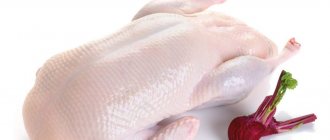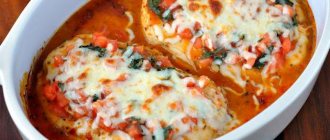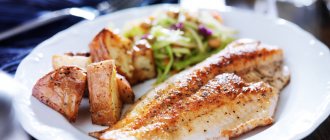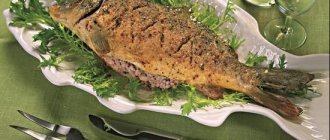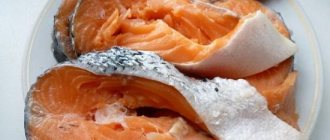Beneficial features
It is recommended to eat fish soup and boiled crucian carp for people suffering from stomach ulcers and gastritis. Freshwater crucian carp stimulates the digestive tract well, activates enzyme production and improves the secretion of gastric juice. The group of amino acids contained in this fish has a strengthening and supporting effect during increased physical and mental stress, and normalizes heart function.
Crucian carp is a marine and, in most subspecies, freshwater fish. It has become widespread throughout our country and Europe. Crucian carp can be silver and gold, with shiny, bright scales. Silver crucian carp is not as fastidious as gold carp, so its numbers are noticeably larger. The size of crucian carp almost never exceeds 40 cm, and its weight is 2 kg.
The World Health Organization recommends eating crucian carp several times a week. This is due to its beneficial properties. The chemical elements included chlorine, phosphorus, calcium, nickel, chromium, iron, potassium, magnesium, molybdenum, sodium, fluorine.
The calorie content of fresh crucian carp is 87 kcal. The composition contains proteins - 17.7 g, fats - 1.8 g.
There are many options for preparing this fish. Crucian carp is smoked, dried, pickled, fried, baked, boiled, dried, stewed. It is important not to forget that with prolonged heat treatment the meat can turn out to be dry and tough, so generally medium-sized specimens are fried for no more than 15 minutes, and boiled for no longer than 10 minutes.
Fresh crucian carp can be bought in the store at almost any time of the year. In this case, the belly and gills should be considered. The first should not be swollen, and the second should be red or pink. Crucian carp meat contains an impressive amount of calcium, and with constant consumption this has a positive effect on the condition of hair, bones and nails. For its excellent properties, it is often prescribed in health-improving diets. Crucian carp can provide the human body with the necessary protein, stimulate the smooth functioning of the stomach and strengthen the general functions of the body.
Chemical composition
Fun fact - this is the most popular nut in the world, although technically it belongs to the legume family. While we won’t remember how many calories are in peanuts, let’s better appreciate its certainly rich chemical composition, because the following vitamins are hidden in each kernel:
- Thiamine – regulates the metabolic processes of proteins, fats and carbohydrates;
- Nicotinic acid – normalizes the functioning of the thyroid gland and adrenal glands;
- Choline - stimulates brain function, supports the nervous system;
- Riboflavin - restores tissues of internal organs, regulates metabolism;
- Pyridoxine – helps cellular processes;
- Pantothenic acid - has an anti-inflammatory effect, promotes cell growth;
- Tocopherol - strengthens the walls of arteries and blood vessels;
- Ascorbic acid - activates iron production, improves the functioning of the immune system.
It also contains minerals - it is important to know about the following elements:
- Copper improves the absorption of iron and has a disinfecting effect;
- Manganese is responsible for the functioning of the endocrine and reproductive systems;
- Magnesium normalizes the functioning of the nervous system, increases the tone of the heart and blood vessels;
- Calcium has an anti-inflammatory effect and improves blood clotting;
- Phosphorus. Strengthens bones, normalizes metabolism and promotes proper liver function;
- Selenium strengthens the immune system;
- Sodium. Improves kidney and gastrointestinal function;
- Potassium. Normalizes water balance;
- Iron normalizes hemoglobin levels in the blood;
- Zinc helps metabolism and strengthens the skeleton.
Although it is important to know the calorie content and nutritional value of peanuts, it is equally important to know its composition - you could be convinced of the exclusivity of the selected components!
The chemical composition of peanuts contains:
- Thiamine (vitamin B1) – 49%;
- Riboflavin (vitamin B2) – 6%;
- Ascorbic acid (vitamin C) – 6%;
- Choline (vitamin B4) – 10.5%;
- Pantothenic acid (vitamin B5) – 35.3%;
- Folates (vitamin B9) – 60%;
- Tocopherol (vitamin E) – 67.3%;
- Biotin (vitamin H) – 80%;
- Nicotinic acid (vitamin PP) – 94.5%.
Indicators are presented per 100 g of product. Two servings of nut mass replenish the body's need for biotin and nicotinic acid. The product contains a number of minerals:
- Potassium – 26%;
- Calcium – 8%;
- Magnesium – 46%;
- Phosphorus – 44%;
- Iron – 28%.
“Nut” contains essential acids, vitamin-like substances, water, sugar, dietary fiber, alcohol and ash. The chemical composition is filled with omega-3 and omega-6 acids, includes poly-, mono- and unsaturated fats, styrene.
Calorie content of boiled crucian carp
Crucian carp belongs to the carp family. The most widespread is freshwater crucian carp, which lives in lakes and rivers of the Russian Federation and Europe, but sea crucian carp can also be found in the coastal waters of the Black Sea. Fish is very affordable and is most in demand in the warm season, when it is sold live.
Crucian carp has all the advantages of freshwater fish, in particular: a rich vitamin composition, easy digestibility and high protein content. Vitamins: A, B1, B2, E, C, PP. Among the chemical elements, it is worth highlighting chlorine, phosphorus, calcium, nickel, chromium, iron, potassium, fluorine, sodium, magnesium.
The calorie content of boiled crucian carp is 102 kcal. The composition also contains proteins - 20.7 g, fats - 2.1 g.
Freshwater crucian carp is not inferior to sea fish in terms of beneficial properties. Both the broth and the meat of boiled crucian carp are very nutritious. Its fillet is very delicate and tender, so small fish are cooked for no more than 10 minutes, otherwise the meat turns out tough and dry. Also, before cooking, freshwater fish should be soaked in a salty solution, and during cooking itself, add various kinds of spices to get rid of the smell of algae. Boiled crucian carp and fish soup made from it should be consumed by people who suffer from stomach ulcers and gastritis. Freshwater crucian carp remarkably stimulates the proper functioning of the gastrointestinal tract, and also has a beneficial effect on better secretion of gastric juice.
When choosing live crucian carp, you should pay attention to the belly and gills. The belly should not be swollen and the gills should be bright red or pink.
Calorie content of boiled crucian carp
is 102 kcal per 100 grams of product.
Crucian carp is a genus of ray-finned fish in the carp family. The body of the crucian carp is tall, with a massive back, slightly compressed from the sides, with large scales. Color, depending on the habitat, from silver-gray to golden. The body length of an adult crucian carp is 40-50 centimeters, weight is 2-3 kilograms. These fish feed on plankton, small invertebrates and various vegetation.
Crucian carp is a tenacious fish, which is why it is used as bait (small crucian carp) for catching pike.
Composition and beneficial properties of boiled crucian carp
Boiled crucian carp meat is rich in minerals that are essential for the human body. It contains: fluorine, calcium, phosphorus, chlorine, chromium, calcium, sodium, magnesium, as well as vitamins B, A, E, C and PP.
Eating boiled fish improves brain function, has a positive effect on the nervous system, and improves vision. In addition, crucian carp contains a small amount of calories, so people who are watching their figure can include it in their diet.
In addition, the benefit of crucian carp is that the flesh of this fish stimulates the digestive system and activates the synthesis of enzymes.
Boiled crucian carp in cooking
When heat treating crucian carp, you should not overcook or overcook it. For this fish, ten minutes of boiling and fifteen minutes of frying is enough, otherwise the fish meat becomes tough and dry.
Boiled crucian carp BZHU for 100 grams
B - 20.7; F - 2.1; U - 0; Calories: 102 kcal per 100 grams of boiled crucian carp.
Application
The taste quality of crucian carp is significantly determined by its habitat. Crucian carp, which is caught in small swamp-like lakes, smells like mud. The most delicious crucian carp are found in large flowing reservoirs. In addition, they are larger than their counterparts and do not absorb foreign odors.
Dishes made from boiled crucian carp are held in high esteem due to the white soft meat of this fish, which is rich in amino acids and all the necessary elements that ensure the vital functions of the body.
First clean the fish from bones, fins and veins, gut it and wash it, place it in a pan and pour water so that the pieces are completely covered with water. Then you need to close the lid tightly and cook in boiling water for 15-20 minutes so that the meat does not lose its taste and does not become tough.
The taste of the dish can be improved by adding parsley and onions to the cooking water. When the crucian carp is cooked, it is transferred to a preheated dish; based on the broth in which it was boiled, you can prepare a sauce - white or tomato.
Market Analytics
- COVID-19 is changing the rules of the game in the cosmetics market
- Beauty of the future: cosmetic innovations 2020
- New ingredients are the driving force of the cosmetics industry
Convenient search for beauty salons on our website
Beauty salons in Moscow Beauty salons in St. Petersburg Beauty salons in Ekaterinburg Beauty salons in Novosibirsk
Latest blog posts on our website
- Naturecream / Geranium (Pelargonium) oil for skin health and beauty
- Prostye-sovety / Save on a beauty salon: procedures that can be done at home
- Naturecream / Growth Factor - brings back youth?
- Oksana-Lezina / 3 effective abdominal exercises from a fitness instructor for beginners
- Prostye-sovety / Making perfect curls at home
- Prostye-sovety / Which hair removal method to choose
- Naturecream / Wrinkles Puppets
- Naturecream / PEPHA-TIGHT - instant skin lifting
- Naturecream / Blue light - a danger to the skin
- Naturecream / Cocoa Butter – A treat for the skin
Latest forum topics on our website
- Mrs._Smith / Badly sunburned! What to do?((
- Ice / Is it necessary to combine fitness classes with a diet?
- Antonova / What can be used for hair loss?
- Radio operatorKat / Who was on a protein diet?
- Suzanna / Mesotherapy on the face
Other articles in this section
| Halibut Halibut is a fish of the northern and Far Eastern seas, belonging to the flounder family. It lives in the northern waters of the Atlantic and Pacific Oceans. Halibut has a unique appearance, which consists in the presence of two eyes in this fish, located one above the other on one side of the body. It is considered a deep-sea fish with a flat body. |
| Horse mackerel in oil Horse mackerel is a small sea fish belonging to the order Perciformes. Lives in warm waters near continents. The horse mackerel's body is oblong, slightly pressed laterally. The main difference is the bony scutes on the sides, located from the head to the tail. |
| Blue whiting Blue whiting is a low-fat and very healthy fish. Despite the fact that it is very difficult to get rid of fish bones, blue whiting products and dishes are becoming widespread. |
| Roach Roach is a type of fish that belongs to the carp family. It is also worth noting that roach is the most common species of fish, as it is sexually active throughout the year. It can live in a wide variety of water bodies, both natural and artificially created. |
| Smoked tuna Sea fish Tuna is a mackerel fish. Adults reach impressive sizes of up to 4 kg, while their weight can be 600 kg or more. Typically found in tropical and subtropical regions. Tuna is often called fish veal. This is because its meat has a distinct taste. This product is widely used in European cooking. |
| Haddock Haddock is a marine fish classified into a monotypic genus called Melanogrammus. An individual haddock is 90-110 cm in length. The average weight of haddock usually does not exceed 3 kg, but quite large specimens weighing up to 19 kg have also been encountered. Haddocks live for about 14-15 years. |
| Pelengas Pelengas is a schooling, semi-anadromous fish from the mullet family. The habitat of this species is the Sea of Japan (especially Peter the Great Bay), as well as some water bodies in Russia and Europe. For example, thanks to an experiment conducted 40 years ago, individuals of the pelengas, ecologically plastic, appeared in the Black and Azov Seas. According to researchers, recently it has begun to explore the waters of the Mediterranean. |
| Salted pike perch Pike perch is a well-known representative of perch. Lives in fresh water bodies and rivers. For its habitat, pike perch prefers exclusively clean water bodies. Therefore, fish does not contain phosphates and harmful impurities. The fish has an elongated body, a gray-green back, and brown stripes on the sides. Pike perch have large, spiny fins. There are many dark spots on the caudal fin. The eyes of pike perch have a yellow tint. The size of an adult individual can reach a meter in length and a weight of 20 kg. Pike perch has white meat with virtually no fatty layers. |
| Lightly salted salmon Salmon belongs to the salmon family, it is considered an anadromous fish and is a valuable commercial object. The maximum weight of one individual can reach 40 kg, and the length can be more than 1 meter. The fish has small scales and does not have any spots below the lateral line. Habitat: the Atlantic and Arctic Oceans, the Baltic Sea. |
| Fresh sea perch In nature, sea perch is found mainly in the Atlantic and Pacific oceans and belongs to the scorpion fish family. It prefers cold temperatures and depths of more than 100 meters to live. |
What is the glycemic index of boiled crucian carp?
The glycemic index of boiled crucian carp is zero.
Cooking boiled crucian carp
Ingredients:
crucian carp to taste salt to taste butter to taste flour to taste water 0.5 cup cream to taste 1 head onion pepper
Salt the cooked fish and refrigerate for 30 minutes. Grind flour with butter, dilute with hot water (0.5 cup) and cream. Bring the liquid to a boil, add fish and onion.
Season the dish with salt and ground pepper. Boil until done, covering the pot with a lid. You need to remove the onion from the finished broth.
Serve boiled potatoes as a side dish. Small crucian carp are boiled whole, large ones are cut in half.
Crucians have always been particularly popular in Rus'. This fish lives almost everywhere, is easy to catch with a regular fishing rod, and is very tasty, satisfying and healthy. There are many ways to prepare it. It is boiled and stewed, fried and baked, smoked and dried. And every time you get an excellent dish that pleases your household. Today we’ll look at what fried crucian carp is. Calorie content, harmful and beneficial properties - read about all this in our article.
Fresh crucian carp
Almost all types of crucian carp are eaten. Silver is especially popular, as it is unpretentious. The golden one also has excellent taste, but its populations are reduced. The maximum weight of the fish reaches 2 kilograms with a size of no more than 40 centimeters.
You can prepare various dietary and low-calorie dishes from crucian carp.
The calorie content of the product is no more than 88 kcal. 100 grams of product contains 17.6 g of protein and 1.7 g of fat. The fish is especially famous for its content of molybdenum, sodium, fluorine, iron, calcium, nickel and phosphorus. In addition, there is some amount of chlorine, potassium and magnesium.
It is recommended to eat fish regularly. Due to the high calcium content, there is an improvement in the condition of hair and nails. Moreover, due to its low calorie content, fish is suitable both for those who want to lose weight and for people forced to adhere to certain diets. But it is always important to remember that this product is not suitable for all people.
It can be done in different ways. Moreover, in each individual case it will be necessary to recalculate exactly how many calories the final product will contain.
Crucians have always been particularly popular in Rus'. This fish lives almost everywhere, is easy to catch with a regular fishing rod, and is very tasty, satisfying and healthy. There are many ways to prepare it. It is boiled and stewed, fried and baked, smoked and dried. And every time you get an excellent dish that pleases your household. Today we’ll look at what fried crucian carp is. Calorie content, harmful and beneficial properties - read about all this in our article.
Carp family
It is to this large class of river inhabitants that our beloved crucian carp belongs. This is a fish with a long dorsal fin and single-row teeth. She has a thick back and compressed sides. The scales are large and can be easily removed. The average weight is 0.7 kg, but there are specimens that are much larger and smaller. You can often find fish weighing three or more kilograms on sale. It is from such specimens that the most delicious fried crucian carp is obtained. In this case, the calorie content will increase, especially when compared with boiled fish. And the prey of amateur fishing most often are small crucian carp, which crunch pleasantly after frying. This dish is best served on the river bank.
Crucian carp - calorie content and properties. The benefits and harms of crucian carp – Yummy
Crucian carp belongs to the fish of the carp family. Its habitat is quite wide and covers the entire territory of modern Russia and Europe. This type of fish is freshwater and thrives in both rivers and lakes.
There are two varieties of crucian carp: silver and gold. Golden crucian carp lived mainly in European reservoirs, and its silver counterpart inhabited the Amur River basin.
In the sixties of the last century, the Soviet Union adopted a program to resettle silver crucian carp throughout the country, which was implemented.
Over time, it independently spread throughout the water basins of Europe and there, thanks to its phenomenal vitality and unpretentiousness to living conditions, it noticeably displaced, and in some places completely replaced, its golden “competitor.”
Beneficial features
Inexpensive and accessible fish is a valuable food product. The content of easily digestible protein and polyunsaturated fatty acids makes it the best product for the prevention of heart attacks and strokes. Doctors recommend eating at least 300 g of crucian carp per week, and more is possible. The low percentage of fat allows this fish to be used in dietary nutrition. Compared to other river inhabitants, even fried crucian carp is quite light. Calorie content per 100 g of product is about 187 kcal.
How many calories are in boiled, fried, baked fish?
The best dietary option is to use fresh, high-quality fish and cook it by steaming or boiling, baking, or stewing. It is not recommended to eat canned, salted, smoked or fried products, as the beneficial properties are lost and the energy value only increases. Adding ingredients such as cream, butter, mayonnaise and cheese also affect the calorie content of the finished dish.
On average, after additional processing, the nutritional value of the product increases by more than 20%.
For example, the calorie content of boiled pike is about 98 kcal. Pink salmon with a calorie content of 142 kcal is recommended to be boiled, baked and stewed (168-184 kcal). The fried product contains 60 kcal more compared to other processing methods. Salmon, whose initial value is 142 kcal, after steaming - 162 kcal. If you need to bake a product, it is best to do it without oil, but using paper or foil.
Composition and calorie content
Fried crucian carp is very tasty, despite the abundance of small bones. However, if the fish is small, then after cooking the small bones will not be so noticeable. And in large specimens the bones are large enough, it will be easy to remove their pulp. In the body of crucian carp, up to 60% of the total mass can be eaten. The fat content is 7%, and the protein content is very high - about 18%.
This is a unique product that contains a huge amount of fat-soluble vitamins. Like other river fish, the humble crucian carp is a source of vitamins A, C, D, E. In addition, it is a source of iodine and manganese, copper and zinc. 100 g of product contains only 87 kcal. It is very low in calories. Fried crucian carp becomes “heavier”, now let’s try to calculate how much.
Fish by-products
But not only the fish itself is worthy of attention. The by-products it contains are also considered no less tasty and healthy. Take caviar, for example. Every female has it at certain times of the year. It also contains a huge amount of proteins and fats. But, unlike fish meat, it also contains carbohydrates. This is important for the overall nutritional value of the product. If we consider river fish, it can be noted that fried crucian carp caviar is considered one of the most delicious. The calorie content of the product is just over 204 kilocalories. This is quite a significant number. It is clear that such a dish is not intended for dietary nutrition. But it is worth noting that caviar initially contains a huge amount of various minerals and fat-soluble vitamins, which do not disappear when fried. They, as in fresh form, strengthen bone tissue, improve vision and brain function, normalize cardiac activity, have a positive effect on the skin and increase immunity. And the number of calories can be easily controlled by the volume of product consumed.
Dietary ration
If you are on a diet, it would be wiser to choose other methods of preparing fish. But everyone knows well how difficult it is to replace the crispy crust with something. Therefore, nutritionists suggest frying fish in the oven. To do this, you need to warm up the oven well, grease the portioned pieces with sunflower oil using a brush and place the baking sheet in the oven for 20 minutes at 200 degrees. Considering the relatively small amount of oil, we can say that this is a very healthy cooking method.
Crucian carp fried in a frying pan
The calorie content of this dish has already been mentioned above, but let's look at this in more detail. So, frying using a lot of oil is not the healthiest way to cook food. But you can use non-stick pans. In this case, the bottom can only be lightly greased with oil, the fish will not burn. However, crucian carp is a delicate fish, and many housewives are afraid to fry it in a dry frying pan. If the fish sticks, it will take a long and tedious time to tear it off. And the appearance will suffer greatly.
Batters and breading
To avoid fish sticking to the pan during cooking, various culinary tricks are used. The simplest technique is to cook fried crucian carp in flour. In this case, the calorie content increases slightly, because the flour itself has nutritional value, and when saturated with oil, it becomes even heavier. Crackers work in a similar way. But it cannot be said that the product becomes excessively greasy. 100 g of fish fried in flour contains no more than 150 kcal. That is, the only question is whether you can stop after this portion.
Crucian fish - benefits and harm to the body
What could be better than relaxing in the fresh air near a pond with a fishing rod in hand? You sit on the bank of the river, holding your breath and not taking your eyes off the float. And he stands there and doesn’t move. Suddenly you notice that he began to slightly
bob on the water. You bide your time. And so the float floated along the river surface, plunging deeper and deeper into the water. You hook the line, pick it up and rejoice because the fish is fluttering on the hook. This is crucian carp.
Crucian carp is the most common type of fish
The most common type of fish is crucian carp. It is found everywhere: in a swamp, a river, a pond. Large crucian carp live in clean running water. Small ones are in the swamps. They can also live in aquariums, as they are unpretentious.
Crucian carp is a fish that lives in fresh water bodies. It can grow up to 60 cm long and weigh up to 3 kg . The size depends on the size of the reservoir in which it lives and its habitat. It has a tall body and a thick back, smooth scales and a long dorsal fin.
Varieties
The aquarium is home to a species of crucian carp - goldfish . It was artificially removed from the silver species by Chinese fish farmers. The correct name is veiltail. With such a beautiful tail, you can catch real crucian carp in a natural reservoir. True, it is very rare.
There are three types of crucian carp: golden , silver and red . The latter has red fins and a tail. And the meat is tougher than other types. The red crucian carp is a natural phenomenon from which the other two species originated, with the silver crucian being bred in ponds for commercial production purposes.
Vitality
Crucian carp is very tenacious. It can go without water for several hours . There is one interesting story about the survivability of this fish.
In place of a dried-up pond, one person decided to make a vegetable garden. When he was plowing the ground, he discovered a pile that was shaped like a fish, and when he broke it, he was simply stunned with surprise. There was live crucian carp in the abundance of foam. He was flat and very thin. How long did he live in the ground? No one knows.
The vitality of crucian carp is also evidenced by the fact that, after being cleaned, they bounce in the frying pan during frying or raise their tails.
Peculiarities
During the winter, crucian carp hibernate, burying themselves in the silt if the reservoir dries out or becomes very shallow over the summer. Sometimes they behave this way when some kind of disaster occurs in nature.
One more feature of this type of fish should be mentioned: the ability to change sex if circumstances require it. For example, a female can turn into a male to continue the race.
Crucian carp reproduce by caviar. The female lays it on algae, and the males fertilize it with milk.
Compound
Crucian carp is a low-calorie food product. 100 g contains 81% protein . This amounts to 87 kcal . Fat – 19%, this is 16 kcal . It is enough to consume 300 g of meat from this fish, and the body is provided with complete protein for 24 hours.
In addition to proteins and fats, this product contains a large amount of useful substances. These are iodine, phosphorus, fluorine, chromium, magnesium, iron, calcium. There are also amino acids.
Crucian carp is a storehouse of vitamins . It contains vitamins of group B, as well as E, C, A.
Harm to health
People suffering from gastrointestinal diseases should not include fried crucian carp in their diet. And it's not just about extra calories. When frying, most of the beneficial substances are lost, that is, the product becomes almost neutral, if not harmful. The load on the body increases greatly, the pancreas and liver are under attack. Therefore, if you adhere to the principles of a healthy diet, it is recommended to eat boiled or stewed crucian carp. You can bake in foil or fry in a Teflon frying pan, with a minimum amount of oil, without flour or other additives.
Crucian carp: benefits and harm, nutritional value, composition, calorie content
Crucian carp belongs to the fish of the carp family. Its habitat is quite wide and covers the entire territory of modern Russia and Europe. This type of fish is freshwater and thrives in both rivers and lakes.
There are two varieties of crucian carp: silver and gold. Golden crucian carp lived mainly in European reservoirs, and its silver counterpart inhabited the Amur River basin.
In the sixties of the last century, the Soviet Union adopted a program to resettle silver crucian carp throughout the country, which was implemented.
Over time, it independently spread throughout the water basins of Europe and there, thanks to its phenomenal vitality and unpretentiousness to living conditions, it noticeably displaced, and in some places completely replaced, its golden “competitor.”
Composition and nutritional value of crucian carp
Crucian carp, as a food product, has enormous value - it belongs to low-fat varieties of fish, the pulp of which contains about eighteen percent of protein, easily digestible by the human body, which makes this type of fish an excellent dietary product.
Nutritional value 100 g:
This fish is rich in polyunsaturated fatty acids, which are important for the prevention of strokes, heart attacks and atherosclerosis.
Also present are fat-soluble vitamins A, B, D, E and various amino acids, which increase immunity and reduce the harmful effects of unfavorable environmental conditions on the body.
The presence of a large number of minerals and trace elements is noted - zinc, phosphorus, manganese, copper. Prevention of osteoporosis is ensured by the presence of calcium in this fish.
The flesh of crucian carp contains a small amount of fat, approximately 7%, and, on the contrary, it contains quite a lot of proteins.
Compared to fatty fish, the energy value of crucian carp is approximately three times less. It is equal to 87 kilocalories per 100 grams of product, when the same herring, for example, has 248 kilocalories per 100 grams.
In general, for people on a diet, this fish is simply an ideal product.
The benefits of crucian carp
According to the recommendations of the World Health Organization, fish should be eaten at least three times a week. At one time, it is enough to eat one hundred grams of fish meat - this amount is the recommended minimum, and if you wish, you can eat fish every day and in any quantity.
The beneficial properties of crucian carp include the following facts:
- Fish can easily replace other sources of protein (poultry, animals), and the essential amino acids in its composition, in addition to the general beneficial effect on the body, improve brain function, increase intellectual abilities, and improve vision with age-related changes.
- These same amino acids are extremely necessary for people with disorders of the cardiovascular system, for the treatment and prevention of heart disease.
- Phosphorus, in combination with calcium and vitamin D, has a positive effect on bone tissue, preventing increased bone fragility.
- Crucian carp ear is useful for ulcers and gastritis, as it stimulates the production of enzymes and gastric juice.
How to eat crucian carp
It is most useful to eat crucian carp in baked or boiled form.
Moreover, preparing the product in question is very easy - just boil the fish in boiling water, adding carrots, onions cut into rings, pepper and bay leaf.
Both the broth and the crucian carp itself are suitable for food. Fish should be cooked no more than ten minutes after boiling, but frying or baking should take a little longer - about fifteen minutes.
In no case is long-term heat treatment of crucian carp recommended, since with prolonged exposure to high temperatures, the protein of freshwater fish “tanns”, and the fish flesh becomes dry and hard.
Please note: as such, no harm to the human body was noted from crucian carp. The only contraindication to its use is individual intolerance. Do not forget that fish of the carp family are carriers of the causative agent of opisthorchiasis (extremely dangerous parasites), so crucian carp can be eaten only after careful heat treatment.
Crucian carp is not only healthy, but also very tasty fish. Many people call it “trash fish,” but doctors say that crucian carp will be useful for people of all ages. By the way, the type of fish in question is low in cost, so crucian carp can be the best option for creating a full menu.
6,908 3
( 175 votes, 4.57 out of 5) Loading...
Source: //okeydoc.ru/karas-polza-i-vred-sostav-produkta/
Crucian carp in sour cream
This healthy, tasty and not too high-calorie dish can be eaten every day. You will need fresh fish, cleaned and washed, cut into portions. Lightly salt and pepper each piece, then spread onto a baking sheet in a single layer. Spread sour cream on top. You can use homemade or store-bought low-fat for this, it all depends on taste. All that remains is to bake in the oven for 20 minutes. Serve with greens, boiled potatoes or vegetable stew. An ideal dish for those on a diet.
When preparing food, special attention is paid to its calorie content. This is especially important for those who pursue the goal of losing weight. In this case, every calorie counts. Crucian carp can be safely called a dietary fish. But its calorie content depends on how it is prepared. Therefore, when calculating the treasured numbers, you need to take into account all the nuances.
Depending on the method of cooking crucian carp, the calorie content will vary
How many calories does fish contain?
As already mentioned, the energy value of fish depends on the variety, since the fish can be fresh, fatty, red or white. The content of fats and proteins in it depends on the variety. How many calories are in fish is the first question for those who want to lose weight. 100 grams of fish contains from 68 to 300 kilocalories, depending on the variety, as well as the method of preparing the fish. Thus, the calorie content of smoked fish will be several times higher than the calorie content of fried fish. If we compare fatty varieties with a minimum amount of fat, the following is observed: the calorie content of red fish is higher than the energy value of white sea or river fish. For dietary nutrition, of course, low-fat varieties of fish are suitable, the calories of which will not have a significant impact on the metabolic processes of obese people. To find out how many calories are in fried or boiled fish, find the answers in search engines, this information is enough. The calorie content of steamed fish will be much lower than the calorie content of fried fish. Boiled fish is certainly a dietary product. Those who really stubbornly struggle with their weight should understand that under no circumstances should they give up fish. Despite the calorie content of fish, its help in losing weight is enormous.
What is crucian carp famous for?
Crucian carp can be called both a marine inhabitant and a freshwater one. It belongs to the carp-like species. The fish has slightly compressed sides, a high body, and fairly large scales. The size of an aquatic inhabitant can vary within very wide limits. Marine representatives average 16-18 cm. It is important to emphasize that more than 60% of the total weight is represented by edible parts. One hundred grams of raw crucian carp meat contains 86-88 calories.
This calorie content is considered very low. To burn 88 calories, just do any housework for 25 minutes.
As already mentioned, the calorie content of foods largely depends on how the fish is prepared. Therefore, you need to consider how many kcal are in 100 grams of crucian carp based on its type. It is also important to take into account that sea fish will be a little fattier, and accordingly it will have more calories.
crucian carp
Crucian carp is a fish of the carp family, which is found almost everywhere in our country. This is a freshwater fish that can live in both rivers and lakes with standing water. Crucian carp are unpretentious in terms of living conditions and food, so they are found in almost every body of water. This explains its important commercial significance: crucian carp are often bred in fish farms.
Crucian carp lives with many aquarium enthusiasts: veil-tailed goldfish in home aquariums are decorative varieties of ordinary river crucian carp. The crucian carp is also the same goldfish from A. S. Pushkin’s fairy tale about the fisherman.
An interesting fact is that crucian carp have the ability to change their gender if necessary. So, if several females are placed in an aquarium, then one of them will definitely become a male over time in order to continue the race.
Crucian carp have a flat but tall body, covered with large scales. The weight and size of the fish depends on its habitat and species. The length of some individuals can reach 50-60 cm, and weight - 2 kg. They reach sexual maturity by the 3-4th year of life. The fish spawns in late spring - early summer, laying eggs on algae. Crucians live up to 15 years.
These are very tenacious creatures: a caught fish can breathe atmospheric air for up to a day, and if it is released into the water during this time, it can come to life. Housewives know that often even cleaned and gutted crucian carp jumps around the frying pan.
Chemical composition
Crucian carp is a moderately fatty fish species. Its meat contains about 18 g of protein and up to 2 g of fat. There are no carbohydrates in crucian carp. This composition of meat determines its low calorie content: 100 g of raw fish contains only 87-88 kcal.
Fats in crucian carp are 70% saturated fatty acids and contain cholesterol. But, taking into account the total amount of fats, their content in this fish can be neglected, since they do not have any special energy or nutritional value. 100 g of raw fish contains no more than 3% of the daily requirement for fat.
The composition of proteins in crucian carp meat is more interesting. They consist of all the essential amino acids necessary for the human body. 100 g of this fish contains almost 30% of the daily protein intake. This means that by eating only 300 g of crucian carp meat, you can provide the body with the daily norm of complete proteins.
The meat of this river fish is rich in vitamins and minerals (macro- and microelements).
Vitamins and minerals Name per 100 g of raw fish, milligrams
| Vitamin A (retinol) | 0,02 |
| Vitamin B1 (thiamine) | 0,06 |
| Vitamin B2 (riboflavin) | 0,17-0,2 |
| Vitamin PP (nicotinic acid) | 5,4 |
| Vitamin C (ascorbic acid) | 1,0 |
| Vitamin E (tocopherol) | 0,4 |
| Potassium | 280,0 |
| Calcium | 70,0 |
| Phosphorus | 220,0 |
| Magnesium | 25,0 |
| Sodium | 50,0 |
| Iron | 0,8 |
| Sulfur | 180,0 |
| Chromium | 0,055 |
| Fluorine | 0,43 |
| Iodine | 0,07-0,08 |
Crucian carp contains a lot (in% of the daily norm of mineral matter) macro- and microelements:
- fluorine (up to 90%);
- iodine (up to 80%);
- phosphorus (up to 28%);
- chromium (up to 25%);
- sulfur (up to 18%);
- potassium (up to 11%).
Beneficial features
The World Health Organization (WHO) recommends eating crucian carp several times a week to provide the body with complete protein. The proteins of this fish are easily digestible and serve as a source of essential amino acids, which are not produced independently in the human body or are produced in small quantities.
Broths made from this fish contain many extractive nitrogenous substances, therefore they stimulate the secretion of digestive juices, stimulate appetite, and accelerate intestinal motility.
The low-calorie meat makes this freshwater fish a good source of protein for people on a diet.
A large amount of fluorine and phosphorus in crucian carp meat affects the processes of ossification and formation of tooth enamel, so their consumption is beneficial for a growing organism - children and women expecting a new addition to the family and breastfeeding. Phosphorus, together with B vitamins, improves brain activity.
Iodine in fish meat is in the form of organic compounds that have high bioavailability. Regular presence of crucian carp dishes in the human diet ensures normal functioning of the thyroid gland and the production of thyroid hormones in sufficient quantities.
Crucian carp dishes are also useful for people suffering from diabetes. Low calorie content, complete protein, no carbohydrates, low fat content, as well as a sufficient amount of chromium in this fish help reduce blood glucose levels and increase the sensitivity of diabetic tissue to insulin.
Vitamins A, C, E and group B affect metabolism in the human body as a whole, improve the condition of skin, hair and nails, and improve mood.
Possible harm
Crucian carp may exhibit any harmful properties when it is caught in water bodies whose water is contaminated with salts of heavy metals, pesticides, radionuclides or organic fertilizers.
Due to feeding on plants and plankton from this reservoir and living in polluted places, large amounts of substances harmful to the human body accumulate in the meat of these fish, which can cause food poisoning, intoxication, intestinal infections or helminthic infestations.
To avoid this, you should not purchase fish at spontaneous markets, along highways or in other places where food products do not undergo veterinary and sanitary examination.
It is not recommended to eat crucian carp if you have an individual intolerance or allergy to crucian carp or fish products. Fish contains phenylalanine, so it should not be consumed by people suffering from phenylketonuria. The protein of this fish, when broken down in the human body, can increase the content of purine bases in the blood, so crucian carp are not recommended for consumption by patients with gout.
Application in medicine
Crucian carp is a low-calorie fish that contains essential amino acids, vitamins and minerals, and does not cause allergies. It can be used for almost any disease:
- heart and blood vessels (improves heart rhythm, normalizes blood pressure, does not affect blood cholesterol levels);
- digestive system (increases appetite, stimulates the secretion of digestive juices, promotes cell regeneration);
- kidneys (reduces swelling, stimulates diuresis);
- blood (increases hemoglobin levels, enriches the protein composition of plasma).
During pregnancy, eating the meat of this fish is beneficial due to the high content of vitamins and essential amino acids, which is necessary for the harmonious development of the fetus. During breastfeeding, eating it enriches breast milk with proteins, vitamins and minerals. Crucian fish soup is good for young children who suffer from weight deficiency and loss of appetite.
Dishes made from this fish are recommended for consumption during and after severe infectious and somatic diseases, operations, and injuries.
How to choose
You can buy crucian carp all year round, but June crucian carp is considered the most delicious. You only need to purchase fresh fish for consumption. The best option would be if the fish is still breathing, then there are no complaints about its freshness. If the fish is no longer breathing, then its freshness can be determined by the following signs:
- The gills should be pink or red. Dull, gray or green gills are a sign that the fish is not fresh.
- There should be a thin layer of transparent mucus on the surface of the body.
- The scales on the fish should be intact, shiny and tightly held.
- The abdomen should be soft, the hole from pressing with a finger on the body should quickly level out.
- The eyes of fresh fish are transparent, shiny, and protruding.
- The fish should have a fishy smell. In crucian carp this smell is often mixed with the smell of mud.
You can store fresh, cleaned, gutted fish in the refrigerator for no more than 2 days. It can also be frozen. At a temperature of -18°C, crucian carp can be stored for up to 6 months.
Use in cooking
Crucian carp is a universal fish in cooking methods. It is fried, boiled, stewed, baked, salted, pickled, smoked, dried. It is delicious in any form. One “but!”: it is very bony, so its meat should be disassembled with special care.
To ensure that there are no bones in a dish made from crucian carp, you need to use one trick. It consists in the fact that along the entire body of each fish it is necessary to make transverse cuts with a knife every 0.5-1 cm (depending on the size of the fish).
Crucian carp stewed in sour cream
This is a classic diet dish that is easy to prepare. To prepare it you will need 1 kg of crucian carp, 0.5 liters of sour cream, onions, lemon, flour for breading, vegetable oil, salt and spices to taste. Clean the fish, gut it, make notches on the barrels. Add lemon juice to get rid of the smell of mud (if any). Salt and sprinkle with spices.
Leave for 20-30 minutes. In a preheated frying pan with vegetable oil, fry the fish coated in flour. Fry over high heat for no longer than 3 minutes on each side to lightly brown. Place the crucian carp on a baking sheet greased with vegetable oil, cover with a layer of onion, cut into rings, and pour sour cream on top.
Bake in the oven at 180°C for 20-30 minutes until golden brown.
Crucian carp is an affordable and very healthy freshwater fish that can and should be on every table several times a week. Its meat is a source of complete protein, minerals and vitamins.
Eating it is recommended at any age and in almost any state of health. At the same time, it has a low calorie content, so it can be consumed by those losing weight.
It is necessary to feed this fish to children with caution, as its meat is very bony. It is necessary to purchase it only in places of authorized food trade in order to avoid buying fish from polluted waters. Not recommended for use if you have gout.
Source: //FoodandHealth.ru/ryba/karas/
conclusions
Crucian carp is an affordable and very healthy freshwater fish that can and should be on every table several times a week. Its meat is a source of complete protein, minerals and vitamins.
Eating it is recommended at any age and in almost any state of health. At the same time, it has a low calorie content, so it can be consumed by those losing weight.
It is necessary to feed this fish to children with caution, as its meat is very bony. It is necessary to purchase it only in places of authorized food trade in order to avoid buying fish from polluted waters. Not recommended for use if you have gout.
Source: //products.propto.ru/article/karas


